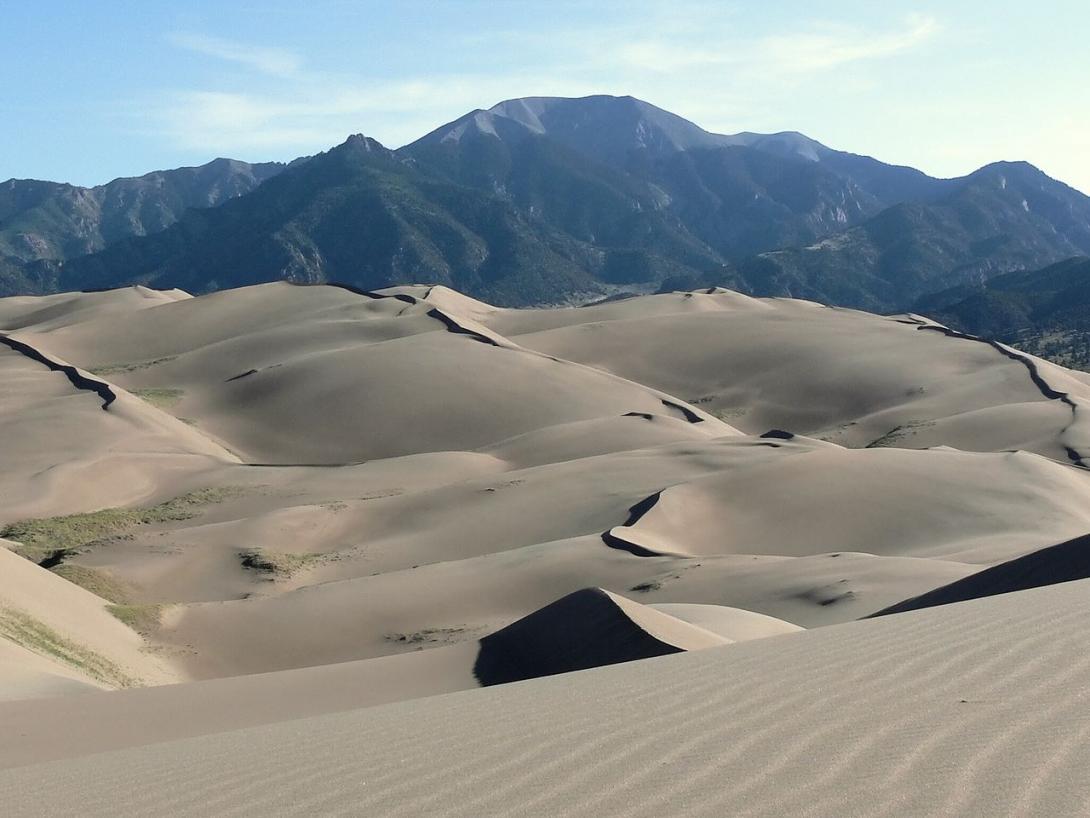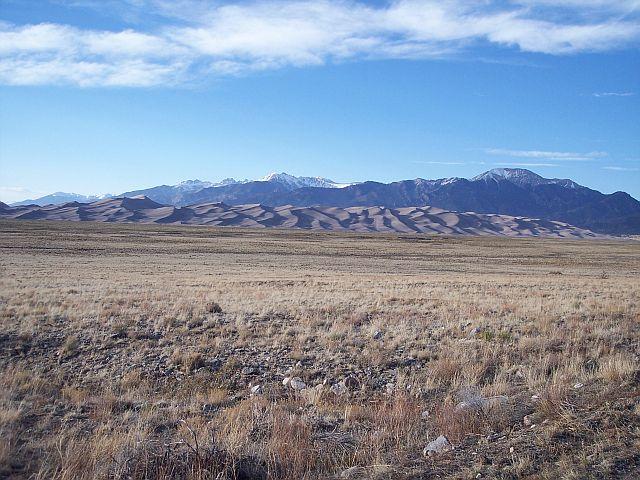Great Sand Dunes National Park and Preserve
Full Article
The Great Sand Dunes sprawl along the eastern fringes of the vast San Luis Valley of south central Colorado, covering an area of nearly thirty square miles. They are the tallest aeolian (wind-produced) dunes in North America, heaping mounds of sand that tower more than 700 feet above the valley floor. The Great Sand Dunes also serve as a cultural crossroads for more than 10,000 years of human history, from Paleolithic big-game hunters to nomadic Native Americans, Spanish conquistadors, transcontinental explorers, hard rock miners, and modern-day tourists in motor homes.
Originally designated as a national monument in 1932, the Great Sand Dunes attained official national park and preserve status in 2004. This stunning landscape now encompasses a spectacular array of natural and cultural features, ranging from the main dunefield and vast sand sheet to verdant wetlands, hardy grasslands, ancient archaeological sites, subalpine forests, and the lofty summits of the Sangre de Cristo Mountains.
Formation of the Dunes
While the exact age of the Great Sand Dunes is unknown, geologists agree that the San Luis Valley’s strong southwesterly winds bear primary responsibility for their initial formation. For untold centuries, prevailing winds have swept loose sand eastward over and across the floor of the valley, piling it near a series of three low passes that form a distinct pocket in the Sangre de Cristo Mountains: Music Pass to the north, Medano Pass in the middle, and Mosca Pass to the south. Funneled into these low passes by the broad flanks of Blanca Peak and the formidable barrier of the high Sangres, the sand-laden wind loses its momentum to friction and turbulence. No longer capable of carrying its load, the wind continually deposits sand at the foot of the Sangres. Northeasterly reversing winds gusting through the low passes in the Sangres in the opposite direction of the prevailing southwesterly winds also contribute to the dunes’ tremendous height.
Wildlife at the Dunes
A surprising variety of animal life thrives in or near the dunes, including at least seven species of native insects that are found nowhere else in the world. The most notable of these is the predatory Great Sand Dunes Tiger Beetle. Kangaroo rats, masters of water conservation, thrive in the vegetated areas among the shifting sands. Raccoons, porcupines, squirrels, and cottontail and jackrabbits browse the grasslands and piñon-juniper forests that surround the dunes. Ravens, swallows, nighthawks, and golden eagles ride the valley’s persistent thermal winds while elk, mule deer, bison, and pronghorn find sustenance amid the shrubs and grasses that dot the broad valley floor. Native predators such as black bears, mountain lions, bobcats, and coyotes prowl the woodlands and foothills adjacent to the dunes. Higher up, bighorn sheep thrive on the rugged flanks of the lofty Sangres. Each of these species has adapted to the harsh, arid conditions of the region, and each contributes to the compelling ecological diversity and complexity of the Great Sand Dunes.
Footprints in the Sand
The first human visitors to the Great Sand Dunes were the Clovis people. Radiocarbon dating of stone tools and projectile points discovered near the Great Sand Dunes indicates that Clovis people first entered the San Luis Valley sometime during the Late Pleistocene era, perhaps as early as 11,000 years ago, followed by the Folsom people around 10,500 years ago. Intense climatic fluctuations during this period produced a moist landscape of interconnected lakes, ponds, and marshes that attracted migrating herds of mammoth, bison, and other large game animals to the region, which in turn attracted the Clovis, Folsom, and later Paleo-Indian cultures to the region. Later Native American cultures included the Apache, Navajo, Pueblo, and Ute, with the latter eventually emerging as the dominant culture in the San Luis Valley. Like the Clovis, the Utes visited the Great Sand Dunes on a seasonal basis only, hunting wild game during the summer months and retreating to warmer climes when winter arrived.
Historians still debate the identity of the first European to arrive in the San Luis Valley; some argue that it was Juan de Zaldívar or his brother Vicente in 1598, while others contend that it was Don Diego de Vargas in 1694. Whoever got there first, the Spaniards who followed in their wake wrote the earliest descriptions of the San Luis Valley and gave Spanish names to many of its natural features. American explorer Zebulon Pike encountered the Great Sand Dunes in January 1807 and described them as appearing exactly like “a sea in a storm.” In 1848 the expedition of John Charles Frémont struggled over the dunes in search of a transcontinental railroad route while Capt. John Williams Gunnison led a similar expedition through the area in 1853. Famed frontier photographer William Henry Jackson took the first known photograph of the dunes in 1874 and described them as “a curious and very singular phase of nature’s freak.”
Monumental Dunes
Around 1870 the discovery of gold in the San Juan Mountains, coupled with the subsequent arrival and expansion of the Denver & Rio Grande Railroad, brought an influx of miners, ranchers, farmers, and settlers into the San Luis Valley. Some of the new arrivals tried homesteading near the Great Sand Dunes, where drifting sand and ceaseless winds frustrated efforts to raise cattle or crops. Meanwhile, gold seekers began staking claims in the Sangres.
By the 1920s, the growing popularity of the Great Sand Dunes for recreation inspired San Luis Valley citizens to advocate for federal protection. The push for preservation accelerated in 1930 when local chapters of the PEO Sisterhood, concerned about attempts to mine gold from the dunes and the extraction of sand for use in concrete, launched a letter-writing campaign directed at local, state, and national politicians. Their efforts were rewarded on March 17, 1932, when President Herbert Hoover named the Great Sand Dunes as the nation’s thirty-sixth national monument.
Visitation grew steadily. Five hundred people came to the newly established monument in 1932; by 1962, the number of visitors had ballooned to nearly 93,000. Improvements to visitor infrastructure during this period included better roads, a new visitor center in 1961, and Pinyon Flats Campground in 1964. By 2004, visitation had increased to more than 267,000 annually.
From Monument to Park
In 1986 a plan by American Water Development Inc. (AWDI) to pump groundwater from the San Luis Valley to the growing cities of Colorado’s Front Range sparked an extended legal battle over water rights. Scientific data accumulated by the National Park Service (NPS) for the court case against AWDI indicated the presence of a much larger aeolian system that was responsible for the existence of the dunes, one that encompassed a series of distinct ecosystems stretching from the mineralized hardpan and vast sand sheet west of the main dunefield all the way to the crest of the Sangre de Cristos. More importantly, the data proved that the Great Sand Dunes were hydrologically connected to the San Luis Valley’s surface and groundwater. Most notably, the waters of Medano and Sand Creeks continually wash eroded sand out to the sand sheet, where prevailing winds blow it back to the dunes. Any threat to that water could result in negative impacts on the Great Sand Dunes.
AWDI lost its legal battle to export the valley’s groundwater in 1991, but in 1995 Stockman’s Water Company launched another scheme to export the San Luis Valley’s water for profit. Like AWDI, Stockman’s encountered fierce opposition from local citizens and eventually abandoned its plans in 1998. In the aftermath of these threats to San Luis Valley water, resource management staff at the Great Sand Dunes—along with a coalition of concerned citizens, conservancy groups, NPS officials, and local, state, and federal politicians—concluded that the best way to ensure perpetual protection for the entire Great Sand Dunes ecosystem was to expand the boundaries of the protected area and designate it a national park.
Local hunters and outdoor advocacy groups initially objected to the plan, concerned that the new national park would prohibit the hunting of elk and bighorn sheep in the Rio Grande National Forest and Sangre de Cristo Mountains. The solution was to establish a preserve in the Sangre de Cristos where hunting and other recreational activities would be permitted. The issue of private development around the dunes was addressed in 1999 when The Nature Conservancy purchased the sprawling Medano-Zapata Ranch to the south and west of the main dunefield, protecting it from development. The Nature Conservancy also began investigating the possibility of purchasing the enormous Baca Ranch to the north and west of the Great Sand Dunes, the site of earlier efforts to export groundwater from the San Luis Valley.
In 2000, after a long and bruising legislative battle, President Bill Clinton signed the Great Sand Dunes National Park and Preserve Act. The act expanded the boundaries of the existing monument by nearly 70,000 acres and created a national preserve on roughly 42,000 acres in the Rio Grande National Forest. It also authorized the purchase of the Baca Ranch, though it would take another four years before The Nature Conservancy’s purchase satisfied the requirements of the bill. Finally, on September 13, 2004, Interior Secretary Gale Norton officially designated Great Sand Dunes National Park and Preserve. Combined, the new park and preserve encompassed 149,512 acres. Most critically, the surface and subsurface water resources of Baca Ranch were protected, ensuring that the entire aeolian system that created and maintained the Great Sand Dunes would remain intact and unimpaired for generations to come.
















